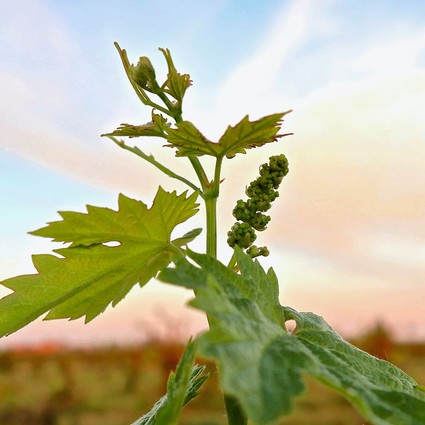Letters from Lodi
An insightful and objective look at viticulture and winemaking from the Lodi
Appellation and the growers and vintners behind these crafts. Told from the
perspective of multi-award winning wine journalist, Randy Caparoso.
Visual discussion of grapevine training during April bud break
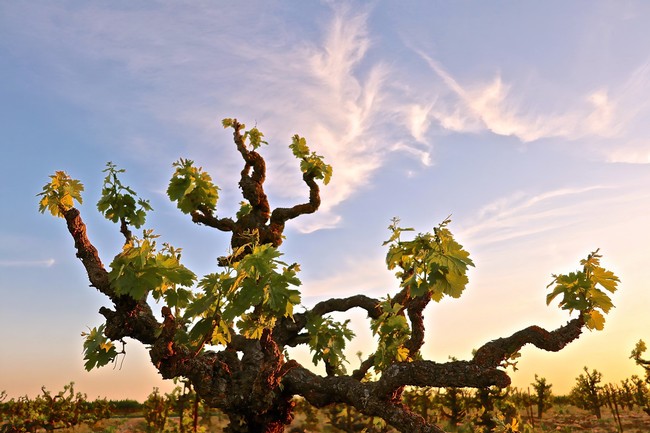
The first week of April is a special time of year, when you can observe early bud break as well as the beautiful "bones" of old vine plantings, such as in this 116-year-old Zinfandel on the east side of Lodi's Mokelumne River appellation.
Bud break and beautiful bones
It’s that time of year when grapevines are bursting all over with new buds. When 2025's spring equinox arrived up this past March 20, most of Lodi wine country’s vineyards were still bereft of these tiny buds. But during the last week of the month, when temperatures finally started to warm up, the bare buds began to swell, and out popped the leaves, unfurling like sails on a ship, along with the tiny precursors of grape clusters, which eventually become the flowers from which individual berries form.
Early spring and April is an interesting season because the bare “bones,” the trunks and limbs, of all the plants are still quite visible. It will be another two months or so before the canes become long enough to drape over and hide the spur positions with grapevine “canopy,” the anatomy consisting of leaves and shoots essential for the process of photosynthesis, necessary to bring plants to fruition.
Ancient vine Lodi Zinfandel during the first week of April: New leaves unfurling like sails on a ship with precursors of grape clusters that will begin to flower and develop as berries in a few weeks' time.
This makes it a great time to be out in the vineyards snapping photos, allowing the eye to study the architecture of the vines, which varies considerably. Let’s talk about some of the basic types of grapevine training, and why each are done in such a fashion...
Head trained, spur pruned old vines (gobelet or goblet, bush)
This is an ancient method of training vines dating at least as far back as the rise of the Roman Empire. It was also the predominant method of grapevine training utilized by the California industry during its first 100 years or so, between 1850 and the 1950s.
Early on in California’s winegrowing history it was found that grape varieties of Mediterranean origin, such as Zinfandel and Carignan, thrived the easiest in California terroirs. These cultivars were best trained as “head trained” vines, tied to single stakes with no supporting wires. The method is often called "bush" or gobelet (or "goblet") outside the U.S. because short, permanent arms or spurs are trained to radiate outwards and upwards from a single head at the top of the vine's trunk, resulting in a goblet-like, or bush-like, shape.

Classic head trained grapevine: The famous "old man walking" plant in Lodi's Marian's Vineyard—recently named California's Vineyard of the Year—an own-rooted Zinfandel planted in 1901, grown so old that some of its elongated, twisting arms are now longer than the vine's hollowed trunk.
However, after 50 years—at which time these vines can be described as "old vine" (according to standards set by California's Historic Vineyard Society—the spurs of head trained vines often become longer than their trunks. After 100 years, they can become twice as long (often over 5-feet) as their trunks.
The permanent spurs are typically pruned back each winter to allow two new canes to grow from the tips of the spurs in early spring. As a result of the horizontal spur positioning, shoot and fruit growth can develop with a circular uniformity. This was historically advantageous because it required nothing more than a stake to keep a vine upright, and this “small vine” configuration also required minimal water, since California viticulture prior to the advent of modern day irrigation systems typically entailed dry farming. That is to say, grapevines were left to fend for themselves, via mature root systems, in order to secure enough water to grow their yearly canopies and ripened fruit.
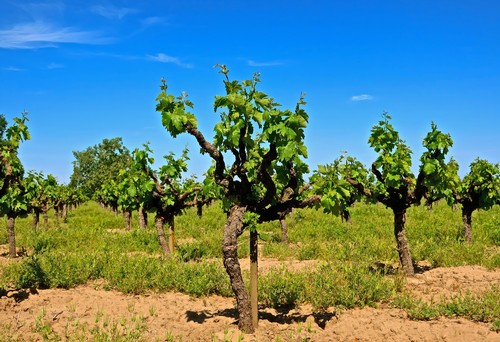
Younger (by Lodi standards, a mid-1970s planting), "gobelet" shaped spur pruned old vine Zinfandel block on the west side of the Mokelumne River AVA.
Lodi, in fact, was an ideal region for #1) head trained Zinfandel and #2) dry farming because of its deep, rich yet well drained fine sandy loam soils allowing for deep root penetration, and because the water table up until the 1930s was just a few feet below the surface. The region’s location, of course, smack dab in between the snow melts of the Sierra Nevada and the intricately leveed Sacramento-San Joaquin River Delta has always given the Lodi grape industry a huge advantage in the way of water resources. The historical center of the Lodi appellation lies within the multiple waterways of the Mokelumne River watershed.
Head training and spur pruning has remained the preferred method of cultivating Zinfandel because the uniformly shaped, umbrella-like canopy provides the ideal combination of shading and dappled sunlight as well as air movement necessary for this particular variety, which is prone to both sunburn and bunch rot. Head training is not to be confused with a similar but different method of "bush" training known as vertical cordon, whereby trunk spur pruned arms are trained to grow vertically up a tall trunk with arms in positions layered in intervals.
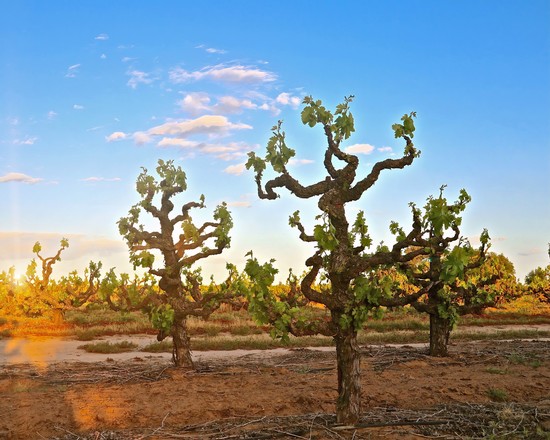
Classic, 5.5-ft. high vertical cordon trained Zinfandel on the east side of Mokelumne River-Lodi.
Vertical cordon trained grapevines
Everywhere you go in Lodi you also see varieties such as Zinfandel, Carignan, Grenache or Cinsaut trained as taller—as much as 5 or 6-feet high—free-standing, spur pruned vines with arms or spurs positoned up and down a single trunk. This method of training has occasionally been described as “ladder” or “layered cake,” but for the sake of distinguishing it from head trained spur pruned vines, we call it “vertical cordon.”
Whereas true head trained, or gobelet style, vines have all their spurs trained from a single head at a point as low as 2 feet off the ground, vertical cordon training allows for permanent spur positions on all sides of a vertical trunk at levels 2, 3, 4, 5 up to 6-feet off the ground.

First bud break at the end of March on this own-rooted Zinfandel which could be described as a double-layered head trained vine, but more correctly as a vertical cordon trained vine.
Vertical cordon training became particularly popular in the Lodi AVA after the 1970s for Zinfandel—especially during the heyday of White Zinfandel (starting in the ‘80s), when the objective was heavy cropping in order to deliver fruit at a lower cost appropriate to the market niche (White Zinfandel typically sold for $5-$10/bottle)—but has also been used for other black-skinned grapes such as Petite Sirah, Mourvèdre, Grenache and Alicante Bouschet.
Over the past 20 years, however, neither head nor vertical cordon trained vines have been utilized in new Lodi vineyards, with a few small scale exceptions (such as patches of Grenache in Lodi's Mokelumne River and Sloughhouse AVAs, a few shrubs of Assyrtiko and Vidiano put in by Perlegos Family, and the Des Voignes family's 9 acres of mixed grapes just coming into their third leaf on Lodi's east side). You see more of these older style plantings recently put into small patches in the Sierra Foothills (Zinfandel and Barbara) or Paso Robles (as part of the latter region's recent push towards "Rhône" varieties).
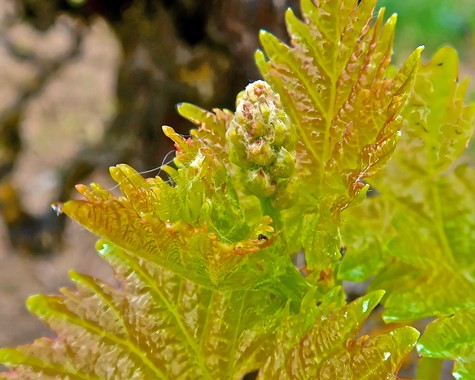
Close-up of early April bud break in old vine block, a future grape cluster emerging like a baby in a womb.
During the 1970s and 1980s, more than a few of the older Lodi Zinfandel blocks populated with small, lower yielding head trained vines were interplanted with higher yielding vertical cordon trained vines in order to increase vineyard production, resulting in blocks where shorter head trained old vines are alternated with taller vertical cordon vines.
In many vineyards planted as far back as 1886 here in Lodi, vines were trained as double layered vertical cordons, resulting in the appearance of a two-story, or quasi-head trained, style of vine. There are also old Carignan blocks in Lodi, dating as far back as 1900, trained on high vertical cordons.
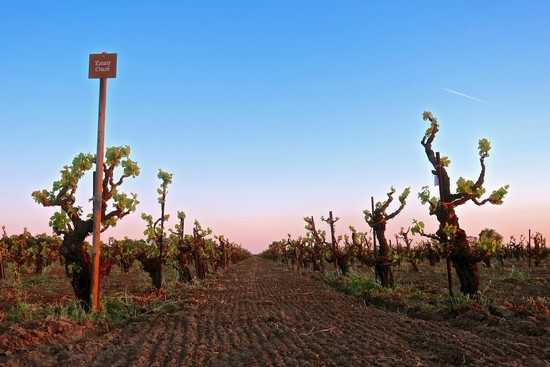
Bechthold Vineyard Cinsaut, Lodi's oldest vineyard, planted in 1886—own-rooted, two-layered vertical cordon trained vines—on early April morning.
Vertical cordon trained vines have the advantage of increased spur positions, resulting in higher yields, which is actually a positive for grape quality in higher vigor sites, since it is a balance of fruit and canopy, not simply lower yields, that produces higher quality wine. These vines are also advantageous for high vigor varieties such as Carignan and Cinsaut. Ease of pruning and picking are also enhanced by the higher spur positions of vertical cordon trained vines.
A possible negative is that vertical cordon vines typically focus more resources at higher spur positions than lower positions—a natural pattern of plant growth known as apical dominance—resulting in uneven growth of vegetation and fruit, although this hasn't kept numerous vertical cordon vineyards from performing at a high level of overall quality.
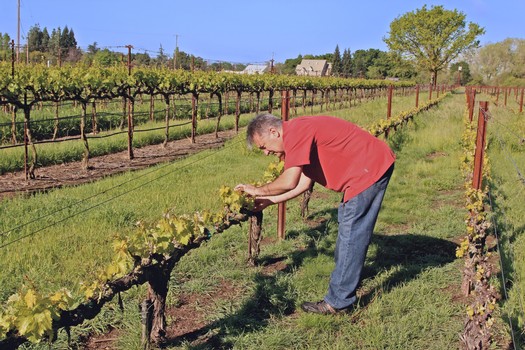
During first week of April, Markus Bokisch attending to Bokisch Vineyards' Mokelumne River-Lodi Tempranillo trained in a low, close-spaced vertical shoot position (i.e., VSP) trellis, whereby shoots growing from permanent bilateral cordons (or arms) are trained upwards to form a vertical curtain that maximizes leaf exposure, hence photosynthesis necessary to ripen fruit.
Trellised vineyards
Lodi grape growers began to transition from single stake vine training to trellised systems in the 1960s and ‘70s, which has since become the predominant fashion of the region (over 85% of Lodi's current acreage was planted only within the past 40 years).
The predominant modern day trellis system utilized all over California is called “vertical shoot position” (VSP), whereby vine shoots are trained upwards, typically from a bilateral cordon—two permanent arms trained horizontally along a lower wire—in a vertical curtain, with the fruiting zone falling just below at the cordons.

During early April bud break, Lodi style modified vertical shoot position (i.e., VSP) trellising: The Des Voignes family's Hartwick Vineyard Orange Muscat, planted in 1993 with cross-arms to hang parallel wires allowing canes to drape over the top and provide partial shade over grape clusters.
In vertical shoot position trellised systems, movable catch wires are typically used to train shoot growth in an upward position as they grow longer in the spring and early summer. The advantage of VSP is that it maximizes both leaf and fruit exposure to sunlight, something necessary especially for cooler climate regions, such as West Sonoma Coast, Santa Barbara or most of Oregon. In warmer, Region IV (on the Winkler Scale) climate zones such Lodi's, VSP works very well for thick-skinned varieties such as Cabernet Sauvignon and Syrah. However, for varieties more prone to sunburn, such as Zinfandel, in Lodi cross-arms are usually utilized in VSP systems to open up canopies at the top and allow canes to drape over the wires in order to create more shading over the fruit zone.
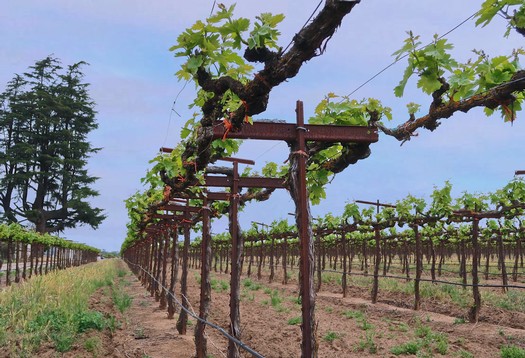
Early April shot of Zinfandel trained on a Wye style divided canopy trellis in Lodi's acclaimed Mikami Vineyard, on the west side of Mokelumne River-Lodi.
Other trellis systems popping up all over California since the 1980s has involved “split" or "divided" canopies, with permanent spur positions trained on two parallel wires, creating a quadrilateral or horizontal configuration. In Lodi in particular, a variation of split-canopy management known as the “Wye” trellis has become very popular; the Wye involving a divided double-cordon system with the arms trained on wires in an ‘S’ shape, creating parallel fruit zones down the vine row and promoting a good balance between leaves and fruit, while allowing for an ideal amount of fruit exposure through dappled sunlight.
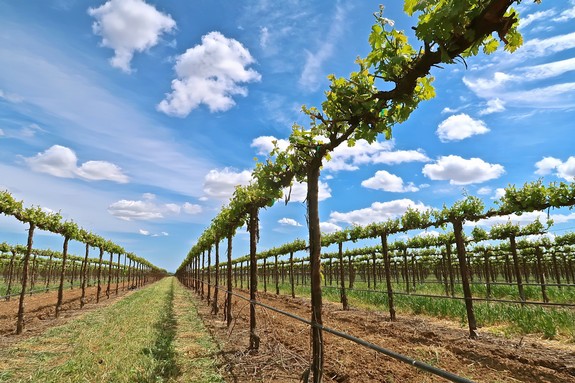
In Lodi Jahant AVA, newly budding Cabernet Sauvignon on single wire, high cordon trellis devised to allow mechanical pruning and harvesting.
Just over the past 10, 15 years the anticipation of both a shortage and escalating costs of vineyard labor has led numerous growers to implement still another method of trellising even more amenable to mechanical pruning and harvesting. This latest style of trellising involves training vines on permanent bilateral cordons on a single wire, typically at least 5.5 or 6-feet off the ground.
Lodi’s LangeTwins Family, one of the region’s industry leaders, describes the new, high single-wire trellising as a “high cordon machine pruning” (HCMP) system. The single wires allow for unimpeded movement of blades or saws of mechanical pruning machines. So far, growers report that this system works well for varieties such as Cabernet Sauvignon and Sauvignon blanc because of these cultivars' naturally upward growth pattern, but it has been challenging for other major commercial varieties, such as Merlot, Pinot noir, Zinfandel and Petite Sirah.
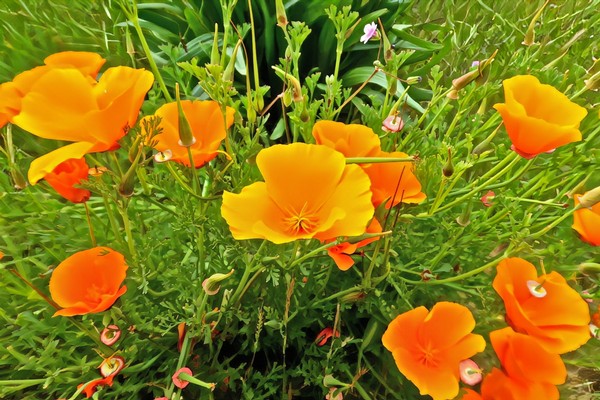
Still another early April sight in Lodi wine country: Roadside California poppies.
